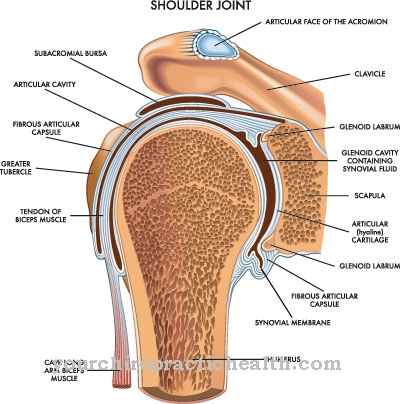The Cutis laxa syndrome is a complex of skin diseases that can be hereditary or acquired and are associated with wrinkled and wrinkled skin. The clinical pictures are completely different. In the following, only the hereditary cutis laxa diseases are described.
What is cutis laxa syndrome?

© designua - stock.adobe.com
Cutis laxa syndrome characterizes a variety of diseases with wrinkled and wrinkled skin. Cutis laxa comes from Latin and means sagging skin. So all diseases show sagging and wrinkled skin. The acquired forms of these diseases are referred to as dermatochalasis. The hereditary cutis laxa forms will be described below.
Although there are a large number of mutations and chromosome changes, the incidence of these diseases is not very high. One in one million people has what is known as the congenital cutis laxa syndrome. So far, only around 200 patients have been described. As already mentioned, it is not a single disease. The main feature of this syndrome complex is sagging skin.
All other symptoms depend on the respective genetic defect. The individual diseases are classified according to the type of genetic defect or according to the clinical appearance. There are autosomal recessive diseases with the abbreviation ARCL. The ARCL are in turn classified according to the location of the affected gene and the clinical picture. There are also the autosomal dominant diseases ADCL. X-linked cutis laxa forms also occur. A few separate types with complex malformations are also mentioned.
causes
The cause of the congenital cutis laxa syndromes are genetic defects on different chromosomes. As already mentioned, there are autosomal recessive, autosomal dominant, x-linked inheritance patterns and diseases with complex hereditary defects. The autosomal recessive diseases ASCL are further subdivided into ASCL of type 1 and ASCL of type 2. ASCL 1 is the cutis laxa syndrome with the most severe course.
The ASCL 1 also has ASCL 1A, ASCL 1B and ASCL 1C. ASCL 1C is characterized by involvement of the lungs, digestive tract, and urinary tract with severe complications. In type 2 ARCL, joint instabilities and development delays are also common. The courses are somewhat milder than in ARCL of type 1. The autosomal dominant form of cutis laxa syndrome ADCL is generally somewhat milder.
However, hernias, heart valve defects, pulmonary emphysema, or diverticula can occur. The x-linked cutis laxa syndromes XRCL are similar in appearance to the ARCL of type 2. There are also special forms of cutis laxa syndromes with complex malformations such as cutis laxa-marfanoid syndrome, MACS syndrome, Sakati-Nyhan syndrome. Syndrome or scarf syndrome.
You can find your medication here
➔ Medicines against skin redness and eczemaSymptoms, ailments & signs
The symptoms of scarf syndromes are varied. The main symptom is always sagging and wrinkled skin. The course and prognosis of the disease are different. The ARCL 1 always leads to death due to complex malformations of the internal organs.
This type is characterized by generalized connective tissue disease with excess and sagging skin, emphysema, vascular abnormalities, and intestinal diverticula. About 60 cases have been described with this form of the disease. Other forms of this syndrome are often much easier and have a normal life expectancy.
diagnosis
The exact diagnosis of the diseases is often very difficult due to the clinical overlap of various symptoms. An intensive family history is first carried out for the examination. This also includes intensive physical exams, imaging tests, histological exams, skeletal exams, liver function tests, kidney exams, and exams of the heart.
The differential diagnoses include Ehlers-Danlos syndrome, Williams syndrome, pseudoxanthoma elasticum, Hutchinson-Gilford syndrome, Barber-Say syndrome, Costello syndrome, cardiofaciocutaneous syndrome, and Kabuki syndrome. Acquired forms of CL should also be considered.
The exact hereditary diagnosis is also important in order to be able to advise the affected families genetically. Direct DNA tests can also be carried out. This makes sense in families in which cases of cutis laxa diseases have already occurred.
When should you go to the doctor?
Since cutis laxa syndrome can have a very negative effect on a patient's appearance, it should definitely be examined by a doctor. The complaints and symptoms can vary significantly, but those affected suffer from sagging and, above all, wrinkled skin. If these symptoms suddenly occur, a doctor must be consulted. Furthermore, the cutis laxa syndrome can also be associated with a malformation of the internal organs, so that in the worst case the affected person can die.
Here, examinations of the internal organs are necessary to determine any damage. Excess skin can also indicate cutis laxa syndrome and should be examined. The first examination and diagnosis is usually made by a dermatologist. Since there is no causal treatment for this condition, treatment is always based on the symptoms. Above all, the damage to the internal organs can be corrected by various specialists. The skin complaints can usually also be corrected through surgical interventions.
Doctors & therapists in your area
Treatment & Therapy
The treatment of cutis laxa syndrome depends on the type of disease. Treatment can only be symptomatic. A causal therapy is not possible with the congenital forms of the disease. Surgical corrections of the skin are also not carried out in the congenital forms of the disease complex. The reason is that the connective tissue has a defect that cannot be repaired even surgically.
The symptomatic treatment of the accompanying symptoms is important in order to save life or improve the quality of life. Therapy can affect the joints, bones, heart, liver, kidneys, or digestive tract. Every organ is surrounded by connective tissue, so that generalized weaknesses of connective tissue can cause functional disorders in almost all organs. There are also diseases of this type that require very little treatment.
Many cutis laxa syndromes are also associated with bone changes. A relatively mild form is the so-called geroderma osteodysplastica, which can be easily differentiated from the other forms of this disease group due to the generalized osteoporosis. In addition to the skin changes, only osteoporosis is of greater importance here, but it can be treated well. The life expectancy of this disease is normal.
Outlook & forecast
As a rule, no general prediction can be made about the further course of the disease in cutis laxa syndrome. However, this disease does not self-heal, so those affected are always dependent on medical treatment.
In addition to the skin complaints, there is also serious damage to the internal organs, which in the worst case can lead to the patient's death. The further course depends very much on the severity of this damage.
The skin is wrinkled and sagging due to the cutis laxa syndrome, so that many sufferers also suffer from reduced aesthetics. In most cases, however, the skin complaints are not corrected surgically, as a correction of the defective connective tissue is usually not possible. Those affected therefore have to live with the skin complaints their entire life.
Damage to the organs or bones must be corrected in order to increase the life expectancy of the person affected. In serious cases, transplants are also necessary. In some cases, the organs are hardly affected by the cutis laxa syndrome, so that no treatment is necessary. The cutis laxa syndrome may reduce the patient's life expectancy. This is especially the case when it comes to malformations or organs so that the cutis laxa syndrome cannot be completely cured.
You can find your medication here
➔ Medicines against skin redness and eczemaprevention
In order to prevent cutis laxa diseases, it is important to know the exact genetic cause. On this basis, human genetic counseling can then be carried out. However, it is often difficult to find out the exact type of disease. Family anamnesis can help if relevant diseases are known within the relatives. Knowledge of the genetic type enables conclusions to be drawn about the inheritance and competent human genetic advice.
Aftercare
With cutis laxa syndrome, there are very few follow-up measures available to those affected. Since it is a hereditary disease, it cannot be completely cured. If the patient wishes to have children, genetic counseling is highly recommended so that the syndrome does not recur in the children.
The cutis laxa syndrome does not have a negative effect on the life expectancy of the person affected, but it can significantly reduce the quality of life. With this disease, the person affected is also dependent on regular examinations and controls by a doctor in order to monitor the symptoms permanently and correctly. In most cases, the symptoms can only be alleviated by using creams, so that those affected are usually dependent on lifelong therapy.
In doing so, attention should be paid to regular use and the correct dosage of these products. Surgical interventions are usually not carried out in cutis laxa syndrome. Since the illness can also lead to depression or other psychological upsets, loving and intensive conversations with family or friends are often very helpful. Contact with other sufferers of the syndrome can also have a positive effect on the course of the disease.
You can do that yourself
In many cases, people suffering from cutis laxa syndrome can lead a relatively symptom-free life. In the positive form, recovery is very likely and the most important self-help measure is limited to regular follow-up checks. This ensures that the disease does not return and that therapy can be initiated directly in the event of a relapse.
The sick should also maintain a healthy lifestyle. Sport and a balanced diet improve the complexion of the skin in the long term and thus also contribute to better mental health. Foods such as whole grains, fruits and vegetables have proven themselves because they not only help the skin, but the whole organism.
In addition, cutis laxa syndrome often requires further operations. These are best accompanied by the sick with rest and care. Due to the high risk of complications, the doctor responsible will usually give specific tips and rules of conduct. These must be strictly adhered to so that there are no health problems during the treatment. Should any complications become noticeable, the responsible doctor must be informed immediately in any case.













.jpg)

.jpg)
.jpg)











.jpg)